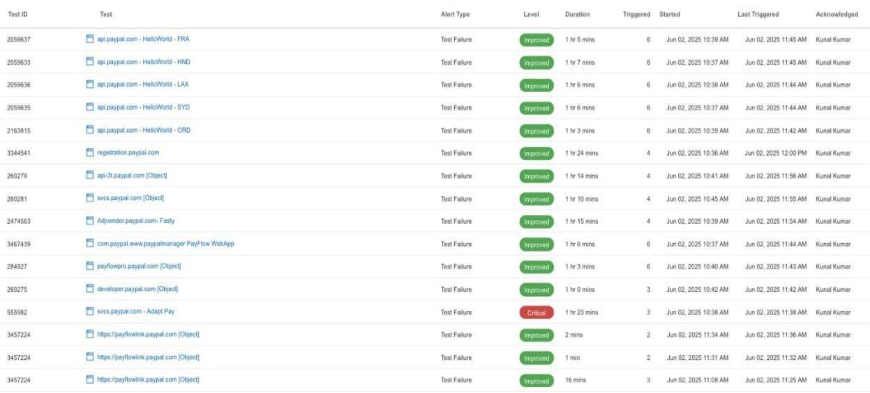When payments pause: lessons from a global payments outage
In digital commerce, payment reliability is non-negotiable. The rise of instant payments highlights this need: global instant payment transaction volume reached 195 billion in 2022, with projections to surpass 500 billion transactions by 2027 as more countries adopt faster payment systems. This growing reliance on real-time payment rails raises the stakes for reliability, with any disruption posing major risks to trust and revenue.
In mid-2025, a leading global payments provider learned this lesson the hard way. A critical backend failure disrupted services across its ecosystem, including digital wallets, merchant platforms, and third-party integrations.
Customer trust: why transparency matters in fintech
For consumers, the impact was immediate: failed transactions, abandoned carts, and frustration. Imagine a small retailer running a limited-time flash sale. Orders surge until payments suddenly stop processing. Customers retry, refresh, and abandon their carts.
For businesses, it meant real losses, stalled revenue, derailed promotions, and shaken customer confidence. This is not just a technical incident. It is a business outage. Lost revenue is visible immediately, but the deeper cost is trust. Once customers question reliability, they hesitate to return. In fintech, trust is currency, and communication during incidents is as important as recovery time.
The event revealed valuable lessons about Internet resilience, observability, and customer trust. These principles define how every fintech and SaaS provider should approach uptime.
What went wrong?
The outage originated from a downstream change in the provider’s application stack. This inadvertently broke valid HTTP/2 responses at the origin Points of Presence (PoPs).
Here’s what unfolded:
- Malformed or aborted HTTP/2 responses caused payment requests to fail.
- Latency spikes and jitter appeared in traceroutes from origin PoPs.
- Synthetic monitoring flagged server parsing errors.
- User reports began to surface on social platforms, amplifying the disruption.
Interestingly, browser traffic that passed through the provider’s CDN remained stable, masking the incident for some end users. Direct API calls, however, used by payment processors, merchant apps, and partner integrations, began to fail. This created a cascading impact across the ecosystem.
The response: containing the fallout

Catchpoint’s Internet Performance Monitoring flagged the incident within minutes, enabling engineers to act before widespread degradation occurred..
Here’s how recovery unfolded:
- Rapid diagnosis of the faulty component in the application stack.
- Traffic rerouting to bypass the affected origin service.
- Full recovery validation via curl tests and synthetic probes.
The team restored full functionality shortly after detection, minimizing financial losses and preserving most user sessions. Even a brief disruption highlighted how little tolerance customers have for downtime in financial transactions.
Key takeaways for engineering and product leaders
This outage highlights lessons that extend beyond one provider:
- Design for failure
Every layer — from CDN to origin to downstream services — can experience issues. Build systems for graceful degradation: architect them to keep running with limited functionality, rather than fail completely, when certain components break. Use patterns like redundancy, load balancing, and service decomposition, and implement health monitoring, robust error handling, and reliable fallback options. This ensures that even during partial disruptions, your users experience minimal interruption and critical services remain available.
- Monitor like a customer
Use synthetic monitoring that simulates real user transactions to catch failures early.
- Communicate transparently
Outages happen. Timely updates manage expectations and reduce frustration.
- Build for bypass
The ability to reroute traffic saved valuable time and minimized downtime.
Resilience requires continuous observability
This incident proves a critical truth: resilience is not a feature, it is a continuous practice. In digital payments, milliseconds matter and transparency defines customer loyalty.
As Internet ecosystems become more complex, observability, failover strategies, and proactive testing are no longer optional. They are essential for uptime, user experience, and long-term trust.
Ready to see what proactive observability looks like?
Experience how Catchpoint’s IPM platform helps you detect issues early, ensure reliability, and keep your users’ trust intact. Request a demo
Summary
A backend configuration change at a global payments provider triggered a widespread outage, breaking valid HTTP/2 responses and halting transactions across APIs and merchant systems. Synthetic monitoring detected the issue within minutes, allowing engineers to isolate the fault, reroute traffic, and restore functionality quickly. The incident highlights three lessons for fintech and engineering leaders: design for failure, monitor like a customer, and communicate transparently. In payments, resilience and observability are inseparable from customer trust.



